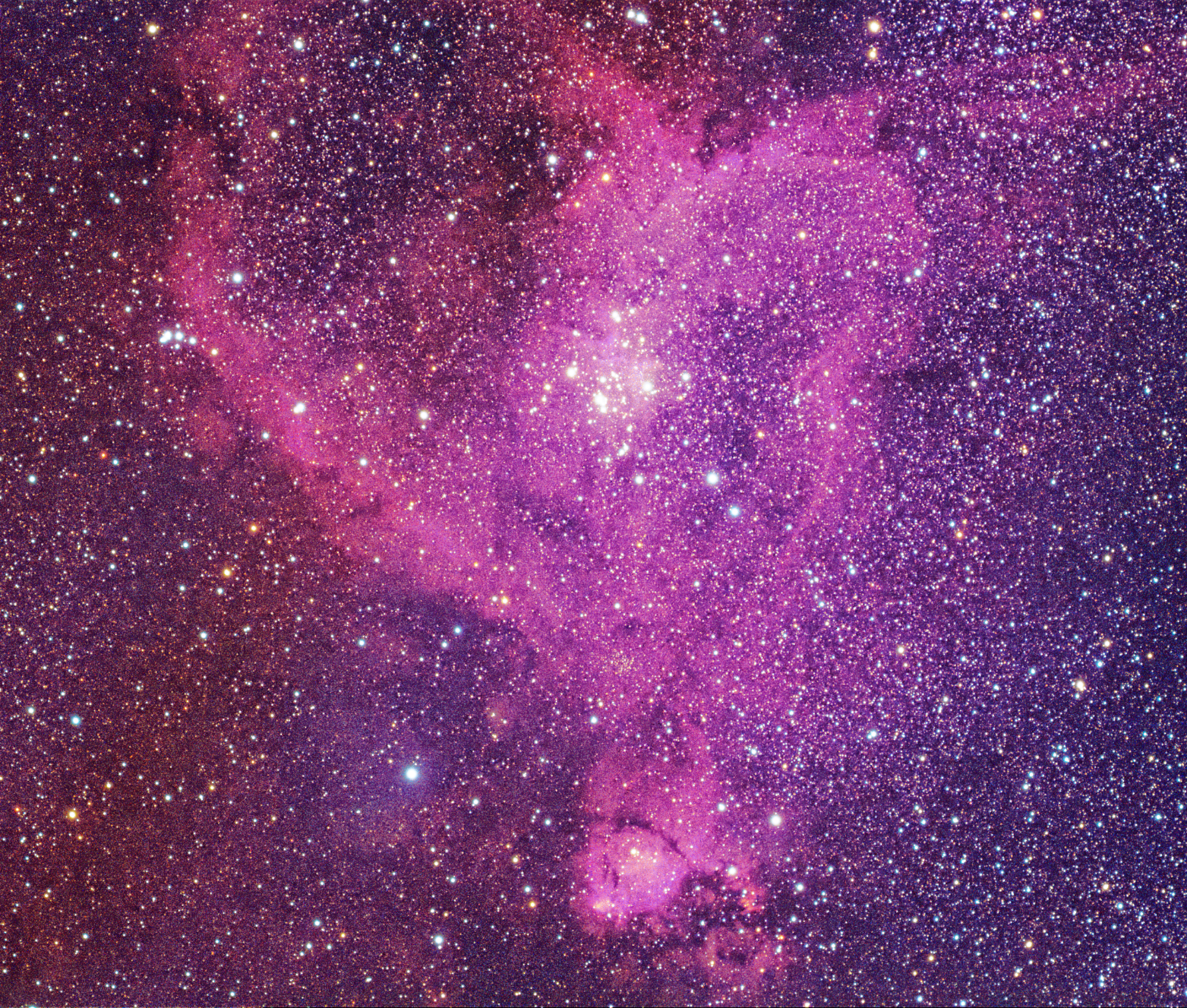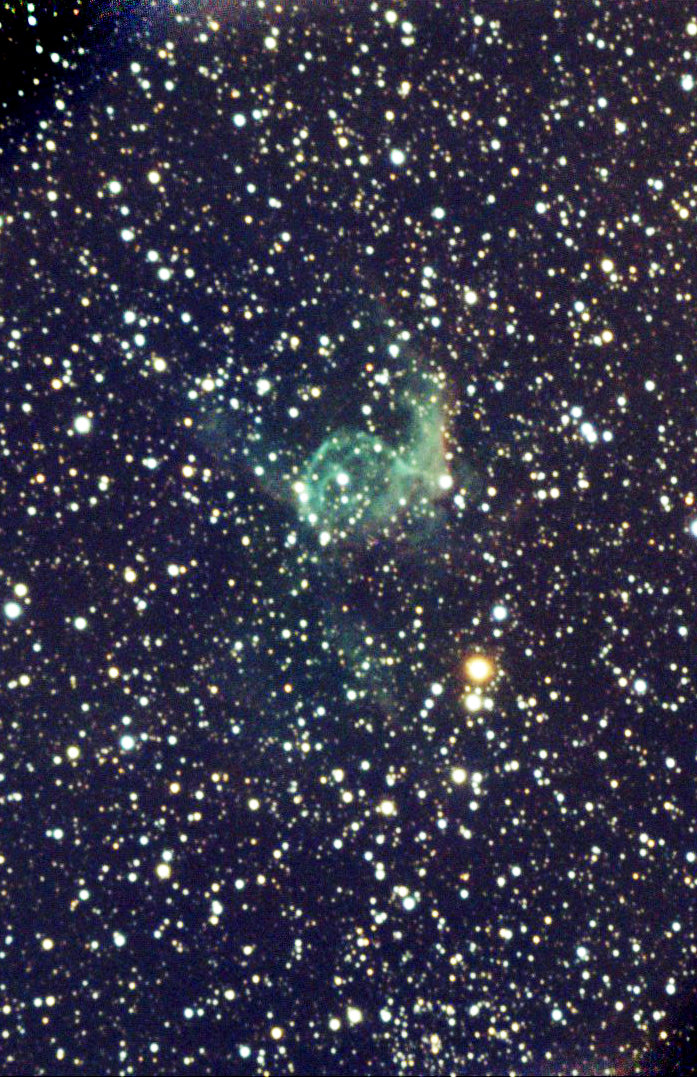𝐀𝐧𝐧𝐢𝐦𝐞 𝐖𝐨𝐧𝐠 on Nostr: Name: IC 1805 - The Heart Nebula Constellation: Cassiopeia Just in time for ...
Name: IC 1805 - The Heart Nebula
Constellation: Cassiopeia
Just in time for Valentines day!
The Heart nebula is located 7,500 ly away, in the southern part of Cassiopeia. It spans over 200 light-years across and is part of a larger star-forming region that also includes the neighboring Soul nebula (IC 1848) and the Fish Head nebula (IC1795) located at the tip of the Heart nebula (it doesn't look much like a fish to me). As is becoming a pattern with most of the objects so far, it was discovered by William Herschel in 1787. However, the structure is so large that many other parts of it were discovered by other astronomers throughout the years, meaning it has multiple designations in various catalogues which is very confusing. That said, unless you're using a large and fast telescope in a very dark area, I doubt you'll see the famous heart shape, or much else here (though it's always worth it to look).
Similar to the Horse Head Nebula and Thor's Helmet. it's an emission nebula, the heart shape is made up of ionized hydrogen that glows primarily in far end of human vision, 656nm, making it hard to see visually. However, there is also Oxygen III (500nm which is green), and Sulfur II emissions (672nm, also red). This can't be seen easily here, but using something called the Hubble palette really brings these colors out, but as a false color image filled with blues for hydrogen and yellows and greens for oxygen and sulfur.
As stated, this is also part of a star forming region. Where you have young stars, you'll have lots of blue O and A type stars. Their light is partially what's blowing away the dust, giving it a heart shape. But these stars are also so bright that illuminating much of this dust. The naturally red emission mixed with the white~blueish light from the young stars reflecting off the dust makes it look pinkish in natural color, really selling the heart shape.

Constellation: Cassiopeia
Just in time for Valentines day!
The Heart nebula is located 7,500 ly away, in the southern part of Cassiopeia. It spans over 200 light-years across and is part of a larger star-forming region that also includes the neighboring Soul nebula (IC 1848) and the Fish Head nebula (IC1795) located at the tip of the Heart nebula (it doesn't look much like a fish to me). As is becoming a pattern with most of the objects so far, it was discovered by William Herschel in 1787. However, the structure is so large that many other parts of it were discovered by other astronomers throughout the years, meaning it has multiple designations in various catalogues which is very confusing. That said, unless you're using a large and fast telescope in a very dark area, I doubt you'll see the famous heart shape, or much else here (though it's always worth it to look).
Similar to the Horse Head Nebula and Thor's Helmet. it's an emission nebula, the heart shape is made up of ionized hydrogen that glows primarily in far end of human vision, 656nm, making it hard to see visually. However, there is also Oxygen III (500nm which is green), and Sulfur II emissions (672nm, also red). This can't be seen easily here, but using something called the Hubble palette really brings these colors out, but as a false color image filled with blues for hydrogen and yellows and greens for oxygen and sulfur.
As stated, this is also part of a star forming region. Where you have young stars, you'll have lots of blue O and A type stars. Their light is partially what's blowing away the dust, giving it a heart shape. But these stars are also so bright that illuminating much of this dust. The naturally red emission mixed with the white~blueish light from the young stars reflecting off the dust makes it look pinkish in natural color, really selling the heart shape.
quoting note1r3l…u236Name: NGC 2359 - Thor's Helmet
Constellation: Canis Major
Did you know that sometimes the gods place memes in the stars?
The naming process for astronomical objects is a mess. Comets always get named by it's discoverer, Asteroids get named by the discoverer. Planets have to be named after Roman gods. Dwarf planets after any gods. Everything else is a bit of a free for all and probably unofficial. It's hard to tell if it's been a long established name, or something people just agreed to use recently. So who called it Thor's Helmet? No idea, but there's nothing stopping me from calling it the Soyjak Nebula.
The Soyjak Nebula is an emission nebula, meaning that it's hot enough to become ionized and glow on it's own, vs a reflection nebula. But it's not an "either or" situation. In fact, much like naming, classification of nebula is also a bit of a mess.
Past that, the Soyjak Nebula is not all that special. The really interesting thing about the Soyjak Nebula is that it's generated (at least partially) by a Wolf–Rayet star.
Wolf–Rayets are extremely rare, only 500 are known in our galaxy of trillions of stars. In the whole Local Group (the cluster of galaxies we are in), an estimated 1000 are believed to exist. I'm not sure exactly why the Milky-way has so many more than the nearby and much larger Andromeda galaxy. Assuming it's not just because we've not done enough wolf hunting, this might mean the Milky-way has more star formation than Andromeda.
This is because Wolf–Rayets are the end stage of the largest O-type stars, the largest stars you can have on the Main Sequence. The largest star we know, the aptly named R136a1, is a Wolf-Rayet.
The Main Sequence is basically a "healthy at any size" diagram... except just like in real life, being slimmer is better. Fat O-type stars don't live very long because they burn through their hydrogen faster than you can burn through that Royal with Cheese and Coke. O-types live no more than a few million years, which is tiny compared to most stars, ( F, G, K-types can live for a few billion years, and the tiny M-types live on the order of trillions of years).
Wolf–Rayets have basically used up most of their hydrogen fuel, and are now actively fusing heavier elements. This can continue until it starts fusing Iron, which is the break even point for nuclear fusion. Once this happens, the star will begin to emit gamma ray in bursts, and soon collapse under it's own weight and become a type Ib or Ic supernova. This means that from that few million years life span of the O-type, Wolf–Rayets probably only have several thousand years left.
The fun things about these stars is that they're very unstable. They also emit mostly in the UV range, and are bright enough to start creating little bubbles of interstellar medium. This makes them very dynamic stars. Probably the most famous WR star candidate is in the Eta Carinae star system, visible only in the southern hemisphere, which went from a star of average brightness, to one of the brightest in the sky, and then dimmed after a massive eruption (now called the Homunculus Nebula) in the span of a few decades.
note1eqp…eg9e




